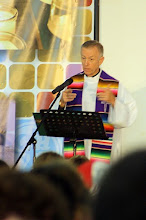My homily this morning contains a synopsis of some of the most central theology of the great German Jesuit theologian Karl Rahner, a peritus (theological expert) at Vatican II, and who died in 1984. He was convinced that the act of faith must never be trivialized by teaching or expecting “immediate return” on prayers—especially those asking for material blessings. I wonder what he thought of sports figures attributing their victories to divine intervention, to say nothing of the now fashionable “Gospel of prosperity” that can be found on television…
His experience (like that of Pope John Paul II and Benedict XVI) was one of living through the horrors of World War II, the Nazis and the communists. In the face of Ha Shoah who can easily expect that faith is anything other than ‘looking into the abyss’? The Jewish Nobelist Elie Wiesel looked and saw night; Jesus from the cross looked and saw Abba-Love.
What do we see when we look? Sometimes our “faith” is simply a benign acceptance of a general sense of well-being in life. But most of us have been challenged at one time or another to take the “deeper look”—usually in the context of a death. Then we resonate far less with Joel Osteen and far more with Jesus’ “My God, my God, why have you abandoned me?” Rahner insisted that ours is authentic faith when it still exists in the "wintry seasons" of our lives.
One person expressed it like this: “Religion is how you hold on; Faith is how you let go.”
More importantly, it was also put like this: “False religion tells you, ‘Relax and fear not; have faith and nothing bad will happen to you.’ True religion, on the other hand, tells you, ‘Have faith; all the bad things you are afraid of happening to you will probably happen. But they are nothing ultimately to be afraid of.’”
How do we let go? In whom and in what do we trust?
Sunday, November 7, 2010
Subscribe to:
Post Comments (Atom)

Just a brief rumination on pathways to perfection, it tends to be a long journey, particularly when one is faced with imperfections of so many strains. When one opens one's mind to the spirit, which is a switch from the secular, a change of attitude occurs. This is best arrived at with the help of a spiritual director, prayerful friends, and continuous religious study. I am always fascinated by the conversion of others. An example is G.K. Chesterton. It seems with his far-reaching intelligence, and a delving nature, he was also influenced by Maurice Baring, a convert in 1901, who prayed unceasingly for Chesterton. He was also quite close to Hillaire Belloc, a staunch, outspoken Catholic. These three thinkers enjoyed many years of friendship. Their thinking processes formed a sphere of knowledge about all aspects of living but with a spiritual bent that led to the conversions of Baring and Chesterton. Relationships are important and fulfilling in
ReplyDeletenurturing spiritual growth.
His relationship with the Catholic J.R.R. Tolkein was what led the atheistic-tending C.S. Lewis to accept the Christian Faith, becoming a member of the Church of England.
ReplyDelete